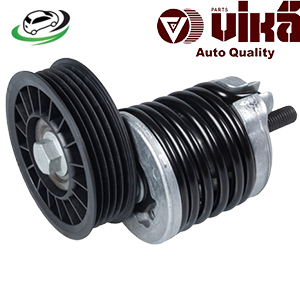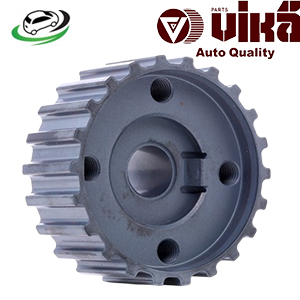-22%
Get AUDI 80 B2 Saloon/ 80 B4 Avant/ 90 B3 / VW Golf II/ Golf III/ Passat B3/B4/ Vento (1H2) Crankshaft timing gear 028105263E
The crankshaft timing gear is a critical component in the internal combustion engine’s timing system. It plays a pivotal role in synchronizing the movement of the crankshaft and camshaft, ensuring that the engine’s valves open and close at the correct times during the combustion cycle. This synchronization is essential for optimal engine performance, efficiency, and reliability. In this overview, we will delve into the function, design, types, maintenance, and significance of crankshaft timing gears.
2. Function of the Crankshaft Timing Gear
The primary functions of the crankshaft timing gear include:
- Synchronization of Crankshaft and Camshaft: The crankshaft timing gear connects to the camshaft via a timing belt, chain, or gears, ensuring that the crankshaft’s rotational movement is matched with the camshaft’s movement. This synchronization allows for precise timing of valve operation, which is crucial for effective combustion.
- Timing Control: The crankshaft timing gear is responsible for controlling the timing of the engine’s intake and exhaust valves. Proper timing is essential to maximize engine power and efficiency, minimize emissions, and prevent engine knocking.
- Driving Accessory Components: In some designs, the crankshaft timing gear also drives various accessories such as the oil pump, water pump, or alternator, contributing to overall engine functionality.
3. Types of Crankshaft Timing Gears
Crankshaft timing gears come in several types, each designed for specific engine configurations and requirements:
- Timing Gears: These are typically found in older engines and consist of a set of interlocking gears that directly connect the crankshaft and camshaft. They provide precise synchronization but can be noisy and require regular maintenance.
- Timing Chains: Many modern engines utilize timing chains instead of gears. Timing chains are made of metal links and are more durable than gears. They tend to last longer but may require tensioners to maintain proper tension and prevent slippage.
- Timing Belts: Timing belts are made of reinforced rubber and are quieter than chains or gears. They are lightweight and provide excellent synchronization. However, they typically have a shorter lifespan than chains and require periodic replacement.
- Variable Valve Timing (VVT) Gears: Some modern engines employ VVT systems that utilize advanced timing gears to adjust the timing of the camshaft dynamically. This technology enhances engine efficiency and performance across various RPM ranges.
4. Design and Construction of Crankshaft Timing Gears
The design and construction of crankshaft timing gears are critical for their effective operation. Key components include:
- Gear Teeth: The gear teeth are designed to mesh precisely with those of the camshaft or timing belt/chain. The tooth profile is engineered to minimize wear and maximize engagement, ensuring smooth operation.
- Material: Crankshaft timing gears are typically made from durable materials such as steel or high-strength plastic composites. Steel gears offer strength and longevity, while plastic gears can be lighter and quieter.
- Tensioning Mechanism: For timing chains and belts, a tensioning mechanism is essential to maintain proper tension and prevent slippage. Tensioners may be spring-loaded or hydraulic and are crucial for optimal performance.
- Mounting Points: The design includes specific mounting points for secure attachment to the crankshaft and camshaft. Proper alignment is vital for effective operation.
- Lubrication: Timing gears, chains, and belts require proper lubrication to minimize wear and reduce friction. Some designs incorporate oil passages or rely on engine oil splash for lubrication.
5. Importance of Crankshaft Timing Gears
Crankshaft timing gears are vital for several reasons:
- Engine Performance: Proper synchronization of the crankshaft and camshaft is essential for optimal engine performance. Incorrect timing can lead to reduced power, poor fuel economy, and increased emissions.
- Reliability: A well-functioning timing system ensures that the engine operates smoothly and reliably. Timing issues can lead to severe engine damage, including bent valves, damaged pistons, and other catastrophic failures.
- Fuel Efficiency: Proper timing allows for more efficient combustion, improving fuel economy. Engines with accurate timing can operate more efficiently, reducing fuel consumption.
- Emissions Control: Correctly timed valves ensure complete combustion, reducing harmful emissions. This is crucial for meeting modern emissions standards and regulations.
- Component Protection: Proper timing reduces the risk of contact between the valves and pistons, which can cause severe damage to engine components. A malfunctioning timing system can lead to costly repairs.
6. Signs of a Failing Crankshaft Timing Gear
Identifying a failing crankshaft timing gear is crucial to prevent engine damage. Common signs include:
- Engine Misfires: A misfiring engine can indicate timing issues. If the timing gear is worn or damaged, it may not maintain proper synchronization, leading to misfires.
- Rough Idling: An engine that idles roughly or shakes may have timing problems. Inconsistent valve operation can cause irregular combustion, leading to rough idling.
- Loss of Power: A significant decrease in engine power, especially during acceleration, may indicate that the timing gear is failing to synchronize properly with the camshaft.
- Check Engine Light: The illumination of the check engine light can be a sign of timing issues. Diagnostic codes may indicate timing-related problems.
- Noisy Operation: Unusual noises, such as rattling or grinding sounds, can indicate that the timing gear or associated components are worn or damaged.
- Oil Leaks: If oil leaks are detected around the timing cover, it may suggest a failing seal or gasket, which could affect the timing gear’s operation.
7. Maintenance of Crankshaft Timing Gears
Regular maintenance is essential to ensure the longevity and performance of crankshaft timing gears. Key maintenance tips include:
- Regular Inspection: Periodically inspect the timing gear, chain, or belt for signs of wear, damage, or misalignment. Catching issues early can prevent costly repairs.
- Oil Changes: Regular oil changes help maintain proper lubrication for the timing system. Clean oil ensures that the gears operate smoothly and reduces wear.
- Timing Belt/Chain Replacement: Follow the manufacturer’s recommended service intervals for timing belt or chain replacement. Neglecting this can lead to catastrophic engine damage.
- Tensioner Maintenance: Ensure that timing chain or belt tensioners are functioning correctly. A failing tensioner can lead to slippage and timing issues.
- Listen for Noises: Pay attention to any unusual noises coming from the timing area of the engine. Addressing strange sounds early can prevent further damage.
- Professional Inspection: If you suspect timing issues, seek professional inspection and diagnostics. A qualified mechanic can identify and resolve timing-related problems.
8. Replacing the Crankshaft Timing Gear
Replacing the crankshaft timing gear can be a complex process, but it is manageable for those with mechanical skills. Here are general steps for replacement:
- Gather Tools and Supplies: Before starting, gather necessary tools, including wrenches, sockets, a torque wrench, and a replacement timing gear, belt, or chain. Ensure the vehicle is parked on a level surface.
- Disconnect the Battery: Safety is paramount. Disconnect the negative terminal of the battery to prevent electrical shorts during the replacement process.
- Remove Engine Covers: If applicable, remove any engine covers that obstruct access to the timing gear. This may involve removing bolts and clips.
- Drain Engine Oil: Place a container under the oil pan to catch the oil. Remove the oil drain plug and allow the oil to drain completely.
- Remove the Timing Gear: Depending on the design, you may need to remove the timing cover and any associated components to access the timing gear. Carefully unbolt the timing gear and remove it.
- Install the New Timing Gear: Position the new timing gear onto the crankshaft, ensuring proper alignment with the camshaft. Secure it with mounting bolts, following the manufacturer’s torque specifications.
- Reinstall Timing Components: Reinstall any timing belts, chains, or associated components that were removed. Ensure proper tension and alignment according to specifications.
- Reinstall Engine Covers: Once everything is in place, reinstall any engine covers and secure them with bolts or clips.
- Refill Engine Oil: After installation, refill the engine with the appropriate type and amount of oil. Follow the manufacturer’s specifications for oil type.
- Reconnect the Battery: Once everything is in place, reconnect the battery and start the engine. Check for any leaks around the timing area and ensure proper operation.
- Monitor Operation: After installation, monitor the engine for any unusual noises or warning lights. Ensure that the engine operates smoothly and efficiently.
9. Conclusion
The crankshaft timing gear is an essential component in ensuring the proper operation of internal combustion engines. Its role in synchronizing the movement of the crankshaft and camshaft is critical for optimal engine performance, efficiency, and reliability. Regular maintenance and timely replacement of timing components are essential for preventing issues that can lead to significant engine damage and costly repairs.
Understanding the function, design, and importance of crankshaft timing gears enables vehicle owners and technicians to ensure their engines operate at peak efficiency, contributing to a safe and enjoyable driving experience. In summary, the crankshaft timing gear is a vital part of the engine’s timing system, playing a crucial role in the overall performance and longevity of the engine.
Follow us on Facebook for more parts.




Reviews
Clear filtersThere are no reviews yet.